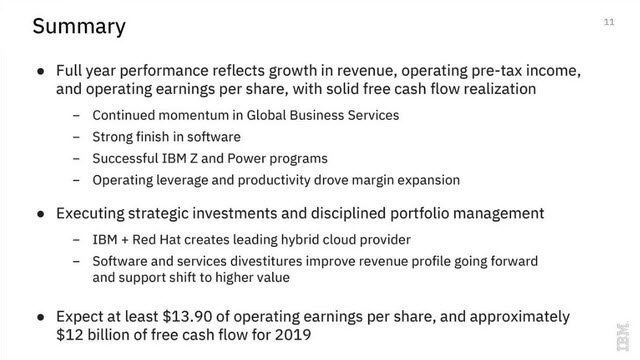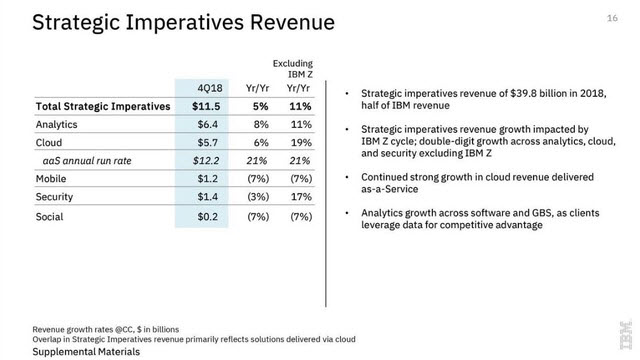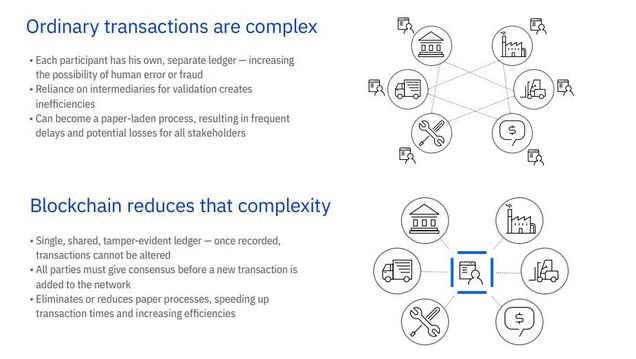International Business Machines (IBM) finally delivered the long-awaited robust quarterly numbers that retail investors and Wall Street had been craving, lifting the stock by 10% in a single session post-earnings. IBM had been trading in the doldrums for months as the bear market in Q4 2018 took the stock down to the sub $120 level, where it traded for months until its Q4 earnings release broke this negative trend. IBM suffered a stock implosion after its Q3 earnings release that fell short of expectations coupled with its announcement that it will be acquiring Red Hat (RHT) for $34 billion. The combination of bad news in conjunction with the bear market backdrop yielded an IBM stock that traded at a 5-year low of $106 with a 5.9% dividend yield. IBM has had a long turn in restoring growth after posting 20+ consecutive quarters of declining revenue however IBM had posted quarters of revenue growth as of late. This growth has come on heels of its long-term imperatives beginning to bear fruit in emerging high-value segments that has fundamentally changed its business mix while evolving its offerings to align with new age information technology demands. The Red Hat acquisition will ostensibly augment its transition away from its dependency on legacy businesses to the future of cloud, artificial intelligence, and analytics. As IBM transitions to quarterly revenue growth, in the backdrop of its evolution to emerging high-value segments (i.e. blockchain) and bringing the Red Hat portfolio into the fold, IBM presents a compelling investment opportunity, despite its recent pop after earnings were announced. In addition to the evolving business mix in strategic imperatives, IBM offers a great dividend, share buyback program while continuously acquiring companies to drive the business into the future.
Q4 Earnings – 10% Post Earnings Pop
IBM reported Q4 earnings of $4.87 EPS and revenue of $21.76 billion which was a -3.5% year-over-year decline however beat analysts’ targets by $30 million on revenue. IBM popped the following day as the company laid out its growth narrative and Red Hat acquisition. In its faster-growing business segments such as strategic imperatives and Cognitive Solutions, revenue grew by 9% and 2%, respectively.
As previously mentioned, last year, the company broke a string of 20 consecutive quarters of declining revenue, which lasted three quarters before dropping again in the September quarter of 2018. Analysts had expected Q4 to continue the trend however IBM increased EPS guidance on its earnings release. FY19 guidance has EPS of at least $13.90 (consensus: $13.81) with FCF of approximately $12B while the Red Hat acquisition is expected to close in 2H19.
Revenue breakdown: Cognitive Solutions, $5.46B (+2% Y/Y in constant currency); Global Business Services, $4.32B (+6% Y/Y); Technology Services & Cloud Platforms, $8.93B (flat Y/Y,); Systems, $2.62B (-20% Y/Y partly on IBM Z cycle dynamics); Global Financing, $402M (-9% Y/Y). Strategic imperatives (cloud, data analysis, etc.) revenue was $39.8B for the year, up 9% Y/Y.
"In 2018 we returned to full-year revenue growth, reflecting growing demand for our services and leadership solutions in hybrid cloud, AI, analytics and security," said Ginni Rometty, IBM chairman, president and chief executive officer. "Major clients worldwide, such as BNP Paribas are turning to the IBM Cloud and our unmatched industry expertise to transform their businesses and drive innovation."
After posting back-to-back quarters of revenue growth, IBM slipped back into a revenue contraction in its Q3 and Q4 numbers however I think there’s a lot to like moving forward. There’s reassurance that the dividend is safe, stabilizing revenues and a lot of shots on goal for future growth especially with Red Hat coming into to fray and strategic imperatives becoming a larger segment of IBM’s overall revenue pie as this is a higher growth business.

Figure 1 – IBM’s Q4 summary and projections for FY2019

Figure 2 – Highlighting IBM’s Strategic Imperatives revenue mix
IBM’s Blockchain Leadership and Healthcare Partnerships
I think IBM has a new frontier of growth in the nascent blockchain technology as the company is a first mover in this promising, emerging technology. IBM’s enterprise blockchain solutions will be a strong growth engine for the company as more companies adopt this technology. Total blockchain spending is estimated to reach $9.2 billion by 2021 with the United States being the biggest investor in blockchain technology. Blockchain has the potential to penetrate the $2 trillion in global payments and $1.8 trillion global supply chain. Recently, healthcare has come into the equation as another huge addressable market. IBM has partnered with CVS Health's Aetna and other insurers on a blockchain network to cut healthcare industry costs. The companies will use the network for processing claims and payments and for maintaining a directory. Anthem, Health Care Services, and PNC Bank are also involved with the project.
To this end, IBM is offering the first enterprise-grade blockchain platform for permissioned networks and is aggressively stepping into the enterprise blockchain solutions space. Any company looking to employ blockchain technology will likely leverage a company like IBM for the blockchain infrastructure as it’s a first-mover in the space and Juniper Research ranked IBM as the top blockchain company in the world with 40% of surveyed tech executives and leaders ranking IBM as their preferred blockchain service provider. IBM is well positioned as it is the #1 enterprise blockchain partner with greater than 400 projects with world-renowned companies across many different sectors involving transactions such as Dow, Walmart, HSBC, Nestle, and Visa.
Per a survey that included 600 executives from 15 territories by PwC, it’s been reported that 84% of firms are “actively involved” with blockchain technology. IBM has more than 400 corporate users that are currently managing various projects on the technology. A total of 63 companies are collaborating in IBM-led consortiums with various themes. 25 companies testing IBM’s blockchain operate in global trade, 14 are in global payments, and 15 are in food supply chain management.
Partners in the food industry are Nestlé, Unilever and Kroger. In global shipping, IBM is working with Maersk, Dow Chemical and DuPont. Maersk, the world’s largest shipping line, launched a joint venture to track international cargo. IBM’s blockchain is seeing inroads in the finance industry as well with Societe Generale, HSBC, WeTrade, Unicredit, and Santander being top partners. IBM is also working with payment providers like VISA, BBVA, CIBC, EarthPort, and Polynesian payments platform KlickEx.
Walmart announced that all suppliers of leafy green vegetables for both Sam’s Club and Walmart must upload their data to IBM’s food safety blockchain solution by September 2019. The IBM Food Trust Solution, which Walmart helped develop, makes the food supply process more transparent and traceable in the event of an illness outbreak. Before the blockchain technology adoption, it took roughly a week to trace the source of food and blockchain reduces the time to a matter of seconds, mitigating the risk of tainted food reaching consumers.
Briefly, Blockchain technology is the architecture that underpins the volatile cryptocurrency markets. This technology applies to enterprise applications since it employs a decentralized database, open ledger, and incorruptible transactional capabilities. Blockchain applies to any transactional business model whether it’s financial or goods being transacted. The open ledger concept within the blockchain makes it incorruptible as any changes need confirmation from multiple parties and any changes can be seen at any time within a permissioned blockchain. As a function of the decentralization, there’s no central repository or clearinghouse to be hacked or accessed. The blockchain speeds up and by-passes these intermediaries (i.e., clearinghouse or bank) to achieve transactions within minutes and not days (Figure 3). The distributed ledger within blockchain establishes a shared, irreversible record of all the transactions that take place within the network. The blockchain enables permissioned access to data in real-time. This allows multiple parties involved to collaborate utilizing a single shared view of a transaction.

Figure 3 – Blockchain and its ability to simplify transactions of all kinds
Red Hat Acquisition Closing 2H19
IBM was acquiring Red Hat (RHT) for $190 per share for a total enterprise value of $34 billion.
"The acquisition of Red Hat is a game-changer. It changes everything about the cloud market. IBM will become the world's #1 hybrid cloud provider, offering companies the only open cloud solution that will unlock the full value of the cloud for their businesses.”
"Most companies today are only 20% along their cloud journey, renting compute power to cut costs. The next 80% is about unlocking real business value and driving growth. This is the next chapter of the cloud. It requires shifting business applications to hybrid cloud, extracting more data and optimizing every part of the business, from supply chains to sales."
- Ginni Rometty, IBM CEO
Most notably, IBM says the acquisition will accelerate IBM's revenue growth, gross margin and free cash flow within 12 months of closing. This growth accelerator is a much-needed boost to the company’s stagnant growth over the past few years and will drive IBM further into the future of the cloud and where businesses are mitigating to from an enterprise perspective. Red Hat is the world’s leading provider of open-cloud solution and the emerging leader in the platform for hybrid-cloud and multi-cloud. IBM is attempting to reset the cloud landscape via its acquisition of Red Hat and in the process will become the undisputed number one leader in hybrid-cloud which is an emerging $1 trillion market.
Companies are moving into the second chapter of the cloud where they’re moving away from simple cost synergies/business value to an inflection point of moving all their processes and their data to a hybrid environment. The first chapter was estimated to be roughly 20% of the cloud market and this second chapter is estimated to be the next 80% with hybrid, multi-cloud, open, secure end-to-end in multi-cloud management.
Red Hat brings 90% penetration in the Fortune 500, and they are now one of the key foundational technologies of the hybrid-cloud. As clients transition to hybrid and multi-cloud, Red Hat can leverage their large installed base and its open architecture. Hence why Red Hat has emerged as one of the key foundational technologies for hybrid cloud computing, all of this feeds into analytics, data, AI and Watson since all that combined data across these environments need to be delivered in a secured manner.
Red Hat – Driving Margin Expansion and Revenue Growth
Red Hat will accelerate IBM’s growth and reinforce its high-value model from a revenue growth standpoint and the shift to higher value. Red Hat had been growing revenue at a strong double-digit rate and a similar level of backlog growth. Red Hat has high margins and great free cash flow generation. Red Hat will accelerate IBM’s top-line revenue growth rate by 200 basis points on a five-year CAGR. Red Hat accelerates the business shift to a higher value and expands gross profit margin, and free cash flow in year one, and operating earnings per share by the end of year two.
From Red Hat perspective, their offerings can now benefit from IBM’s scale and resources to enhance the development and continued improvement of its infrastructure, management, automation solutions, and cloud application development. IBM believes that this will bring revenue synergies and clearly stated that it’s not about a cost synergy case, but a revenue growth case because this acquisition is about growth.
Conclusion
IBM is hot coming off of its blowout Q4 earnings and has bounced off it 5-year lows by gaining 10% in one trading session. The company is continuing to slowly realign itself for future growth with new and emerging end markets while making acquisitions for future growth (i.e., $34 billion acquisition of Red Hat). Red Hat is the world’s leading provider of open-cloud solution and the emerging leader in the platform for hybrid-cloud and multi-cloud with 90% penetration into the Fortune 500. IBM is attempting to reset the cloud landscape via its acquisition of Red Hat and in the process will become the undisputed number one leader in hybrid-cloud which is an emerging $1 trillion market. Red Hat will accelerate IBM’s top line revenue growth and its business shift to a higher value with margins expanding and free cash flow generation.
Its long-term imperatives are beginning to bear fruit in emerging high-value segments that has fundamentally changed its business mix while evolving its offerings to align with new age information technology demands. Blockchain technology has yet to be broken out as a revenue line item. However, IBM is a first mover in this promising, emerging technology with partnerships across all industries and recently healthcare. IBM is aggressively stepping into the enterprise blockchain solutions space, and it may be a substantial growth engine for the company. IBM offers a compelling long-term investment opportunity given its attractive valuation, dividend, share buyback program and growth initiatives with secular trends (cloud, security, AI and blockchain) with large addressable markets
Noah Kiedrowski
INO.com Contributor
Disclosure: The author does not hold shares of IBM however may engage in options trading surrounding this underlying security. The author has no business relationship with any companies mentioned in this article. He is not a professional financial advisor or tax professional. This article reflects his own opinions. This article is not intended to be a recommendation to buy or sell any stock or ETF mentioned. Kiedrowski is an individual investor who analyzes investment strategies and disseminates analyses. Kiedrowski encourages all investors to conduct their own research and due diligence prior to investing. Please feel free to comment and provide feedback, the author values all responses. The author is the founder of stockoptionsdad.com a venue created to share investing ideas and strategies with an emphasis on options trading.
